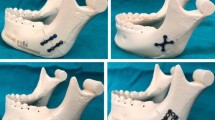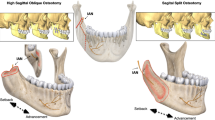Abstract
Objectives
Biomechanical loading on human mandibles was performed and a new optical measurement device was introduced for the quantification of interfragmentary movement in fractured mandibles stabilized with different osteosynthesis systems.
Materials and methods
Comparison tests were performed with monocortical non-locking double plates and bicortical single locking plate. For the experiments on a specialized test bench, 18 ex vivo fractured human cadaveric mandibles were tested. Interfragmentary motion was detected in all three spatial dimensions using the optical measurement device PONTOS®. The movement was investigated over increasing incisal force and one summarized parameter was investigated.
Results
For the maximal tested load of 300 N m, the resultant interfragmentary movements in the two investigated groups were 2.96 ± 1.85° for the fixation with two conventional miniplates (six hole, profile 1.0 mm) and 4.53 ± 2.49° for single bicortically fixed locking plates (four hole, profile 1.5 mm). For both plate systems, we used the 2.0 mm screw system.
Conclusions
The test bench in combination with the new optical device PONTOS® can test the primary stability of osteosynthesis. We offer a solution to the problem of rate of twist of the mandible as well as typical rotational problem in recent measurements. Further, the method can be used for development of new osteosynthesis products.
Clinical relevance
Pseudoarthrosis formation is a common problem based on unsatisfying fixation of the fracture gap. The here presented combination of mechanical tests and numerical simulations can provide support for an improved treatment of fractured mandibles.








Similar content being viewed by others
References
Champy M, Lodde JP, Schmitt R, Jaeger JH, Muster D (1978) Mandibular osteosynthesis by miniature screwed plates via a buccal approach. J Maxillofac Surg 6(1):14–21
Champy M, Wilk A, Schnebelen JM (1975) Die Behandlung der Mandibularfrakturen mittels Osteosynthese ohne intermaxillare Ruhigstellung nach der Technik von F.X. Michelet. Zahn Mund Kieferheilkd Zentralbl 63(4):339–341
Gerlach KL, Pape HD (1980) Prinzip und Indikation der Miniplattenosteosynthese. Deutsche zahnarztliche Zeitschrift 35(2):346–348
Gerlach KL, Schwarz A (2003) Belastungsmessungen nach der Miniplattenosteosynthese von Unterkieferwinkelfrakturen. Mund Kiefer Gesichtschir 7(4):241–245
Burm JS, Hansen JE (2009) The use of microplates for internal fixation of mandibular fractures. Plast Reconstruct Surg 125(5):1485–1492
Claes L, Augat P, Suger G, Wilke HJ (1997) Influence of size and stability of the osteotomy gap on the success of fracture healing. J Orthop Res 15(4):577–584
Piffko J, Homann C, Schuon R, Joos U, Meyer U (2003) Experimentelle Untersuchung zur biomechanischen Stabliltat unterscheiedlicher Unterkieferosteosynthesen. Mund Kiefer Gesichtschir 7(1):1–6
Goodship AE, Kenwright J (1985) The influence of induced micromovement upon the healing of experimental tibial fractures. J Bone Joint Surg 67(4):650–655
Wolf S, Janousek A, Pfeil J, Veith W, Haas F, Duda G, Claes L (1998) The effects of external mechanical stimulation on the healing of diaphyseal osteotomies fixed by flexible external fixation. Clin Biomech (Bristol, Avon) 13(4–5):359–364
Karoglan M, Schutz K, Schieferstein H, Horch HH, Neff A (2006) Development of a static and dynamic simulator for osteosyntheses of the mandible. Technol Health Care 14(4–5):449–455
Meyer C, Kahn JL, Lambert A, Boutemy P, Wilk A (2000) Development of a static simulator of the mandible. J Craniomaxillofac Surg 28(5):278–286
Rudman RA, Rosenthal SC, Shen C, Ruskin JD, Ifju PG (1997) Photoelastic analysis of miniplate osteosynthesis for mandibular angle fractures. Oral Surg Oral Med Oral Pathol Oral Radiol Endod 84(2):129–136
Dobele S, Horn C, Eichhorn S, Buchholtz A, Lenich A, Burgkart R, Nussler AK, Lucke M, Andermatt D, Koch R et al (2010) The dynamic locking screw (DLS) can increase interfragmentary motion on the near cortex of locked plating constructs by reducing the axial stiffness. Langenbecks Arch Surg 395(4):421–428
Neff A, Muhlberger G, Karoglan M, Kolk A, Mittelmeier W, Scheruhn D, Horch HH, Kock S, Schieferstein H (2004) Stabilitat der Osteosynthese bei Gelenkwalzenfrakturen in Klinik und biomechanischer Simulation. Mund Kiefer Gesichtschir 8(2):63–74
Schieferstein H (2003) Experimentelle Analyse des menschlichen Kausystems. Technische Universität, München
Koolstra JH, van Eijden TM (1992) Application and validation of a three-dimensional mathematical model of the human masticatory system in vivo. J Biomech 25(2):175–187
Koolstra JH, van Eijden TM, Weijs WA, Naeije M (1988) A three-dimensional mathematical model of the human masticatory system predicting maximum possible bite forces. J Biomech 21(7):563–576
Pruim GJ, de Jongh HJ, ten Bosch JJ (1980) Forces acting on the mandible during bilateral static bite at different bite force levels. J Biomech 13(9):755–763
Waltimo A, Kononen M (1993) A novel bite force recorder and maximal isometric bite force values for healthy young adults. Scand J Dent Res 101(3):171–175
Baragar FA, Osborn JW (1984) A model relating patterns of human jaw movement to biomechanical constraints. J Biomech 17(10):757–767
Nickel JC, Iwasaki LR, Walker RD, McLachlan KR, McCall WD Jr (2003) Human masticatory muscle forces during static biting. J Dent Res 82(3):212–217
Osborn JW, Baragar FA (1985) Predicted pattern of human muscle activity during clenching derived from a computer assisted model: symmetric vertical bite forces. J Biomech 18(8):599–612
Koolstra JH (2002) Dynamics of the human masticatory system. Crit Rev Oral Biol Med 13(4):366–376
Hölzle F, Franz EP, Lehmbrock J, Weihe S, Teistra C, Deppe H, Wolff KD (2009) Thiel embalming technique: a valuable method for teaching oral surgery and implantology. Clin Implant Dent Relat Res
Franz Härle MC, Terry BC (2009) Atlas of craniomaxillofacial osteosynthesis: microplates, miniplates, and screws, 2nd edn. Thieme, Stuttgart
Shetty V, McBrearty D, Fourney M, Caputo AA (1995) Fracture line stability as a function of the internal fixation system: an in vitro comparison using a mandibular angle fracture model. J Oral Maxillofac Surg 53(7):791–801, discussion 801-792
Joos U, Piffko J, Meyer U (2001) Neue Aspekte in der Versorgung von Unterkieferfrakturen. Mund Kiefer Gesichtschir 5(1):2–16
De Marco TJ, Paine S (1974) Mandibular dimensional change. J Prosthet Dent 31(5):482–485
Fischman B (1990) The rotational aspect of mandibular flexure. J Prosthet Dent 64(4):483–485
Steinhauser E, Diehl P, Hadaller M, Schauwecker J, Busch R, Gradinger R, Mittelmeier W (2006) Biomechanical investigation of the effect of high hydrostatic pressure treatment on the mechanical properties of human bone. J Biomed Mater Res 76(1):130–135
Acknowledgment
We would like to thank the International Bone Research Association (IBRA), Basel, Switzerland, for making these studies possible by providing essential support with a research grant.
Conflict of interest
On behalf of all authors of this manuscript, we certify that there is no actual or potential conflict of interest in relation of this article. Additionally, we declare that there exists no financial or personal relationship with other people or organizations that could inappropriately influence this work.
Author information
Authors and Affiliations
Corresponding author
Rights and permissions
About this article
Cite this article
Steiner, T., Raith, S., Eichhorn, S. et al. Evaluation of a new optical measuring system for experiments on fractured human mandibles. Clin Oral Invest 16, 1535–1542 (2012). https://doi.org/10.1007/s00784-011-0659-z
Received:
Accepted:
Published:
Issue Date:
DOI: https://doi.org/10.1007/s00784-011-0659-z




